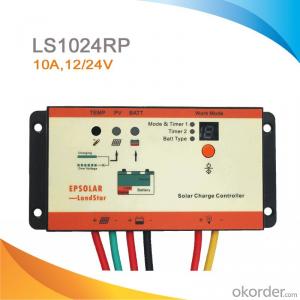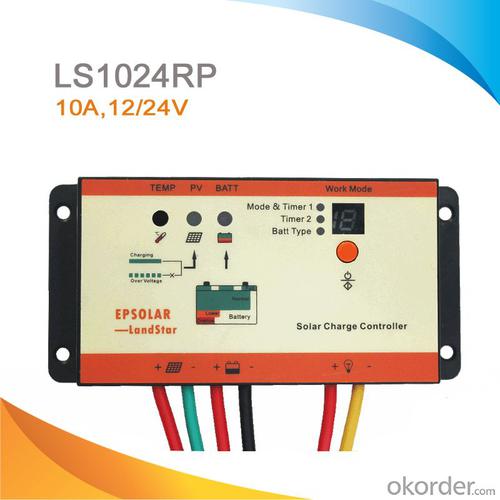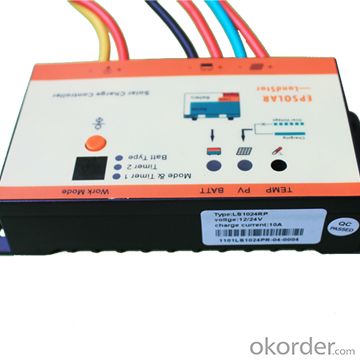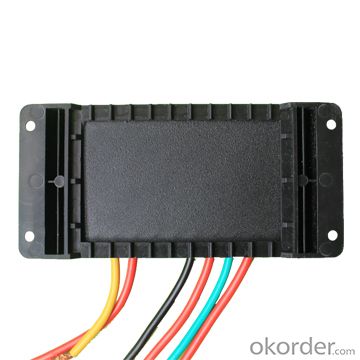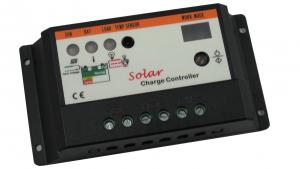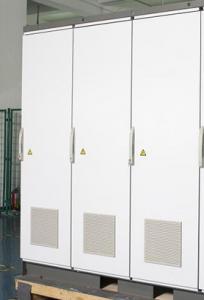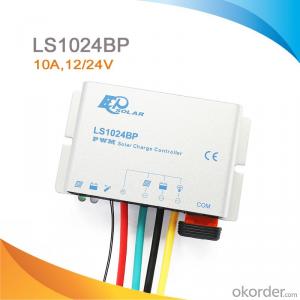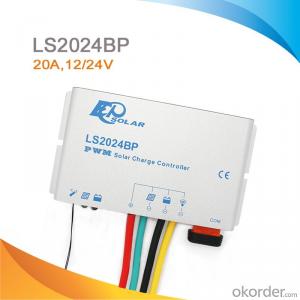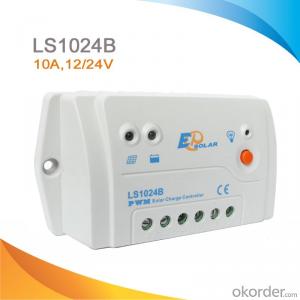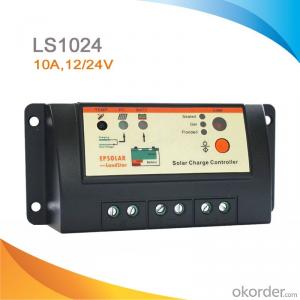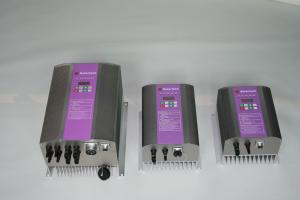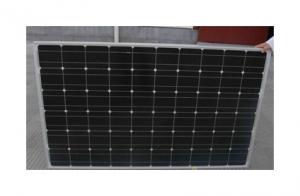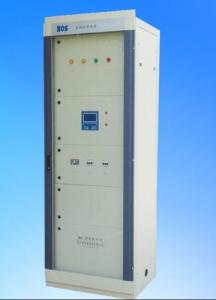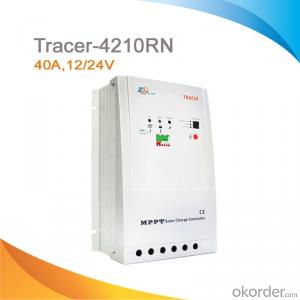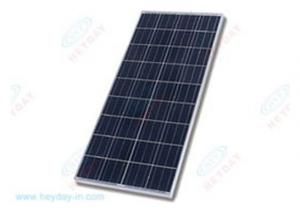Solar Controllers from South Korea Supplier - PWM Waterproof Solar Road Controller, 10A, 12/24V LS1024RP
- Loading Port:
- China main port
- Payment Terms:
- TT or LC
- Min Order Qty:
- -
- Supply Capability:
- -
OKorder Service Pledge
OKorder Financial Service
You Might Also Like
Features:
·Waterproof design
·High efficient Series PWM charging
·Gel, Sealed and Flooded battery type option
·Widely used, automatically recognize day/night
·Intelligent timer function with 1-15 hours option
·Use MOSFET as electronic switch
·Digital LED menu with simple setting and easy using
·Temperature compensation
·Reverse protection: any combination of solar module and battery
Electronic Protections:
·Overheating
·Over discharging
·Over charging
·Load overload
·Load short circuit
·PV short circuit
·PV reverse polarity
·Battery reverse polarity
Specification:
Electrical parameters | LS1024RP | LS2024RP |
Nominal System Voltage | 12 / 24VDC auto work | |
Rated Battery Current | 10A | 20A |
Max. Battery Voltage | 32V | |
Charge Circuit Voltage Drop | ≤0.26V | |
Discharge Circuit Voltage Drop | ≤0.15V | |
Self-consumption | ≤6mA | |
Overall dimension | 145 x 69 x 31mm | 145 x 85x 34mm |
Wire diameter | 4mm2 | 6mm2 |
Net weight | 0.3kg | 0.4kg |
Working temperature | -35℃ to +55℃ | |
Humidity | 10%-90% NC | |
Enclosure | IP66 | |
Battery Voltage Parameters (temperature at 25℃) | |||
Battery charging setting | Gel | Sealed | Flooded |
Equalize Charging Voltage | —— | 14.6V;x2/24V | 14.8V;x2/24V |
Boost Charging Voltage | 14.2V;x2/24V | 14.4V;x2/24V | 14.6V;x2/24V |
Float Charging Voltage | 13.8V;x2/24V | 13.8V;x2/24V | 13.8V;x2/24V |
Low Voltage Reconnect Voltage | 12.6V;x2/24V | 12.6V;x2/24V | 12.6V;x2/24V |
Low Voltage Disconnect Voltage | 11.1V;x2/24V | 11.1V;x2/24V | 11.1V;x2/24V |
Equalize Duration | —— | 2 hours | 2 hours |
Boost Duration | 2 hours | 2 hours | 2 hours |
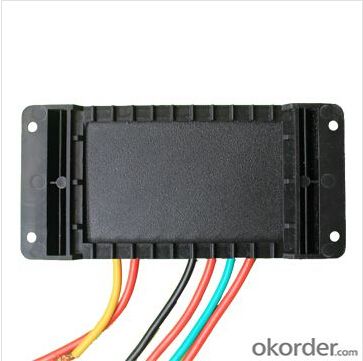
FAQ:
Q1. What is the voltage?
A1. Our 45/60A solar charge controller is 12/24/36/48V auto work.
Q2. What is the difference between MPPT&PWM?
A2. MPPT has higher efficiency, it can track the max power point and won't waste energy.
Q3. What is the efficiency of the MPPT controller?
A3. MPPT>99%, peak conversion efficiency>98%.
Q4. What is the waranty of product?
A4. 12 months.
Q5. What protection does your MPPT controller have?
A5. PV array short circuit, PV reverse polarity, Battery reverse polarity, Over charging, Output short circuit.
- Q: How do I ensure proper ventilation for a solar controller installation?
- To ensure proper ventilation for a solar controller installation, it is important to place the controller in a well-ventilated area. This can be achieved by installing the controller in a location with adequate airflow, away from direct sunlight or heat sources. Additionally, leaving enough space around the controller for air circulation and avoiding any obstructions will help maintain proper ventilation.
- Q: How does a solar controller handle temperature fluctuations?
- A solar controller handles temperature fluctuations by continuously monitoring the temperature and adjusting the charging parameters accordingly. It regulates the flow of power from the solar panels to the batteries, ensuring that the batteries are charged optimally and preventing damage due to overcharging or undercharging. Additionally, advanced solar controllers may feature temperature compensation, where they adjust the charging voltage based on the ambient temperature to maximize the efficiency and lifespan of the batteries.
- Q: Can a solar controller be used with solar-powered indoor hydroponics systems?
- Yes, a solar controller can be used with solar-powered indoor hydroponics systems. A solar controller helps regulate and optimize the charging process of batteries connected to solar panels. In indoor hydroponics systems, solar panels can be used to generate electricity, which can then be stored in batteries. The solar controller ensures that the batteries are charged efficiently and protects them from overcharging or excessive discharge. This allows for the sustainable and independent operation of indoor hydroponics systems using solar power.
- Q: What is the role of a solar controller in maximizing solar panel efficiency?
- The solar controller holds a crucial role in maximizing the efficiency of solar panels, as it ensures optimal performance and protection of the solar panel system. Known also as charge controllers or solar regulators, these devices are responsible for regulating the energy flow between solar panels and batteries or electrical loads. One of the key functions of a solar controller is to avoid overcharging the batteries. As solar panels generate electricity, they continuously charge the batteries. However, overcharging can cause damage and reduce the batteries' lifespan. The solar controller carefully monitors the battery voltage and ensures that the charging process remains controlled and optimized, preventing overcharging and extending battery life. Furthermore, solar controllers also safeguard batteries against deep discharge. When the batteries are not being charged, they may discharge power back into the solar panels, leading to damage and reduced efficiency. The solar controller addresses this issue by disconnecting the solar panels from the batteries when the voltage drops below a certain threshold. This preserves battery capacity and prevents damage. Moreover, solar controllers contribute to maximizing solar panel efficiency by maximizing power output. They employ Maximum Power Point Tracking (MPPT) technology, which allows the solar panels to operate at their highest power output regardless of temperature or shading changes. MPPT technology continuously adjusts the voltage and current to find the optimal operating point for the solar panels, ensuring they consistently produce the maximum amount of power possible. To summarize, the solar controller's role in maximizing solar panel efficiency involves regulating energy flow, preventing overcharging and deep discharge of batteries, and utilizing MPPT technology to optimize power output. Through these functions, solar controllers ensure the solar panel system operates at its highest efficiency, maximizing the generation of clean, renewable energy.
- Q: Can a solar controller be used with solar trackers?
- Yes, a solar controller can be used with solar trackers. A solar controller is typically used to regulate and optimize the charging of batteries in a solar power system. It monitors the voltage and current from the solar panels and ensures that the batteries are charged efficiently and safely. Solar trackers, on the other hand, are devices that follow the movement of the sun throughout the day, maximizing the solar energy output by keeping the solar panels aligned with the sun's position. They use motors or actuators to adjust the orientation of the solar panels. While solar controllers and solar trackers serve different functions, they can be used together in a solar power system. The solar controller will be connected to the solar panels and batteries to manage the charging process, while the solar tracker will adjust the position of the panels to capture the maximum amount of sunlight. By combining both technologies, the solar power system can benefit from increased energy generation and improved battery charging efficiency. This can lead to higher overall system performance and increased energy output.
- Q: How does a solar controller handle variations in load power requirements?
- A solar controller handles variations in load power requirements by constantly monitoring the power output from the solar panels and adjusting the charging current accordingly. When the load power requirement increases, the solar controller increases the charging current to meet the demand. Similarly, if the load power requirement decreases, the solar controller reduces the charging current to prevent overcharging. This dynamic adjustment ensures that the load power requirements are met efficiently while maintaining the optimal charging conditions for the batteries.
- Q: Are there any safety precautions I should take when installing a solar controller?
- Yes, there are several safety precautions that should be taken when installing a solar controller: 1. Turn off all power sources: Before beginning the installation process, make sure to turn off all power sources to the solar controller and disconnect any batteries or power supplies that may be connected to it. This will help prevent any electrical shocks or accidents during the installation. 2. Wear protective gear: It is important to wear appropriate protective gear, such as safety glasses and gloves, while installing a solar controller. This will protect you from any potential injuries or accidents that may occur during the installation process. 3. Follow manufacturer's instructions: Carefully read and follow the manufacturer's instructions provided with the solar controller. This will ensure that you adhere to the recommended installation procedures and safety precautions specific to the particular model you are installing. 4. Check for proper grounding: Ensure that the solar controller is properly grounded according to the manufacturer's instructions. This will help protect against electrical faults and reduce the risk of electrical shocks or fires. 5. Avoid water exposure: Solar controllers should not be installed in areas where there is a risk of exposure to water or moisture. Avoid installing the controller in damp or wet locations, as this can lead to electrical hazards and damage to the equipment. 6. Use appropriate wiring and connectors: It is crucial to use the correct wiring and connectors recommended by the manufacturer for the solar controller installation. This will ensure proper electrical connections and reduce the risk of short circuits or other electrical accidents. 7. Seek professional assistance if needed: If you are unsure about any aspect of the installation process or do not have the necessary skills or knowledge, it is advisable to seek professional assistance. This will help ensure that the solar controller is installed correctly and safely. By following these safety precautions, you can minimize the risks associated with installing a solar controller and ensure a safe and successful installation process.
- Q: What brand of solar controller is good
- Do you ask the controller for photovoltaic power generation?
- Q: Can a solar controller be used with solar-powered indoor ventilation systems?
- Solar-powered indoor ventilation systems can indeed utilize a solar controller. The role of a solar controller is to regulate the transfer of electricity from solar panels to the ventilation system. Its purpose is to enhance the system's efficiency and effectiveness, thereby maximizing the utilization of solar energy. Regardless of whether the ventilation system is installed indoors or outdoors, both the solar panels and the ventilation system can be linked to the solar controller. This connection allows for power supply management and optimal system performance.
- Q: Can a solar controller be used with a solar tracker?
- Yes, a solar controller can be used with a solar tracker. A solar controller is responsible for regulating the charging and discharging of batteries in a solar power system, while a solar tracker helps to maximize the efficiency of solar panels by following the sun's movement. By integrating a solar controller with a solar tracker, the system can effectively manage the power generated by the solar panels, ensuring optimal performance and battery charging.
Send your message to us
Solar Controllers from South Korea Supplier - PWM Waterproof Solar Road Controller, 10A, 12/24V LS1024RP
- Loading Port:
- China main port
- Payment Terms:
- TT or LC
- Min Order Qty:
- -
- Supply Capability:
- -
OKorder Service Pledge
OKorder Financial Service
Similar products
Hot products
Hot Searches
Related keywords
